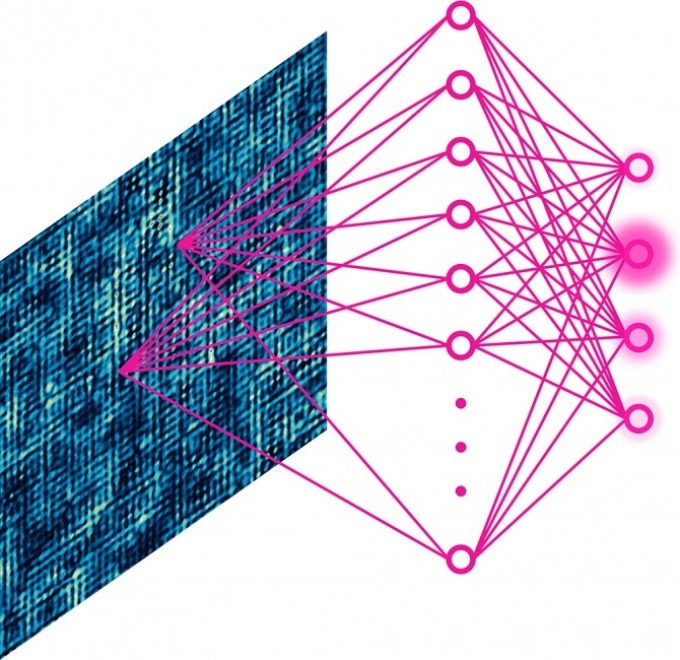Jun 21 2019
Interpreting the complex behavior of electrons has resulted in discoveries that have considerably redefined society; for example, the invention of transistors has revolutionized computing.
 A schematic illustrating how a neural network is used to match data from scanning tunneling microscopy to a theoretical hypothesis. (Image credit: Cornell University)
A schematic illustrating how a neural network is used to match data from scanning tunneling microscopy to a theoretical hypothesis. (Image credit: Cornell University)
Currently, developments in technology have enabled a deeper analysis of electron behavior when compared to the earlier days, possibly allowing scientific innovations as world-changing as the personal computer. Conversely, these tools produce extremely complex data that cannot be easily interpreted by humans.
Now, a research team headed by Cornell University has developed a new method in which machine learning can be applied for studying the data produced by scanning tunneling microscopy (STM)—a method that creates subatomic-scale images of electronic movements in the surfaces of materials at varying energies, offering data that otherwise cannot be achieved through other techniques.
Some of those images were taken on materials that have been deemed important and mysterious for two decades. You wonder what kinds of secrets are buried in those images. We would like to unlock those secrets.
Eun-Ah Kim, Professor, Department of Physics, Cornell University
Kim is the senior author of “Machine Learning in Electronic Quantum Matter Imaging Experiments,” which was recently reported in the Nature journal on June 19th, 2019. First authors of the paper are Yi Zhang, formerly a postdoctoral researcher in Kim’s laboratory and currently at Peking University in China, and Andrej Mesaros, also a former postdoctoral researcher in Kim’s laboratory and presently at the Université Paris-Sud in France.
J.C. Séamus Davis, Cornell University’s James Gilbert White Distinguished Professor in the Physical Sciences and an innovator in STM-driven studies, is the study co-author.
The study provided a new understanding of the way electrons interact with one another, demonstrating how machine learning can be effectively used for driving more discoveries in terms of experimental quantum physics.
A specified sample, at the subatomic scale, will include countless numbers of electrons communicating with one another as well as the surrounding infrastructure. The behavior of electrons is partly established by the tension existing between their two competing tendencies— to stay far away from one another, linked with repulsive interaction energy; and to move around, linked with kinetic energy.
In this analysis, Kim and collaborators set out to find out which of these competing tendencies are more significant in a high-temperature superconductive material.
Using the STM technique, electrons travel via a vacuum between the surface of the sample being studied and the conducting tip of the microscope, offering comprehensive data about the behavior of electrons.
“The problem is, when you take data like that and record it, you get image-like data, but it’s not a natural image, like an apple or a pear,” stated Kim. The instrument produced data that is more like a pattern, she added, and approximately 10,000 times more complex than a conventional measurement curve. “We don’t have a good tool to study those kinds of data sets.”
In order to interpret this data, the scientists replicated an ideal setting and introduced factors that would induce variations in electron behavior. Next, they trained an artificial neural network to detect the situations related to diverse concepts. The artificial neural network is a type of artificial intelligence that is capable of learning a particular activity by utilizing techniques inspired by the way the brain works.
When the team fed the experimental data into the neural network, it established which of the theories were most resembled by the actual data.
According to Kim, this technique established the theory that the repulsive interaction energy had a more influential effect on the behavior of electrons.
A deeper knowledge of the number of electrons interacting under different conditions and on different materials may possibly lead to future discoveries, Kim stated, including the fabrication of novel materials.
The materials that led to the initial revolution of transistors were actually pretty simple materials. Now we have the ability to design much more complex materials. If these powerful tools can reveal important aspects leading to a desired property, we would like to be able to make a material with that property.
Eun-Ah Kim, Professor, Department of Physics, Cornell University
Researchers at Stanford University, Brookhaven National Laboratory, San Jose State University, Harvard University, the National Institute of Advanced Industrial Science in Japan, Oxford University, and the University of Tokyo also contributed to the study.
The study was supported by organizations, including the Cornell Center for Materials Research, the National Science Foundation, the U.S. Department of Energy, and the Kavli Institute for Theoretical Physics.